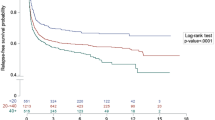Abstract
In bone marrow transplantation studies, patients are followed over time and a number of events may be observed. These include both ultimate events like death and relapse and transient events like graft versus host disease and graft recovery. Such studies, therefore, lend themselves for using an analytic approach based on multi-state models. We will give a review of such methods with emphasis on regression models for both transition intensities and transition- and state occupation probabilities. Both semi-parametric models, like the Cox regression model, and parametric models based on piecewise constant intensities will be discussed.
Similar content being viewed by others
References
Andersen PK, Hansen LS, Keiding N (1991) Non- and semi-parametric estimation of transition probabilities from censored observation of a non-homogeneous Markov process. Scand J Stat 18: 153–67
Andersen PK, Borgan Ø, Gill RD, Keiding N (1993) Statistical models based on counting processes. Springer-Verlag, New York
Andersen PK, Keiding N (2002) Multi-state models for event history analysis. Stat Methods Med Res 11: 91–15
Andersen PK, Klein JP (2007) Regression analysis for multistate models based on a pseudo-value approach, with applications to bone marrow transplantation studies. Scand J Stat 34: 3–6
Cheng SC, Fine JP, Wei LJ (1998) Prediction of cumulative incidence function under the proportional hazards model. Biometrics 54: 219–28
Commenges D (1999) Multi-state models in epidemiology. Lifetime Data Anal 5: 315–27
Commenges D (2002) Inference for multi-state models from interval-censored data. Stat Methods Med Res 11: 167–82
Cook RJ, Lawless JF (2007) The statistical analysis of recurrent events. Springer-Verlag, New York
Datta S, Satten GA (2001) Validity of the Aalen-Johansen estimators of stage occupation probabilities and Nelson-Aalen estimators of integrated transition hazards for non-Markov models. Stat Probab Lett 55: 403–11
Fine JP (2001) Regression modeling of competing crude failure probabilities. Biostatistics 2: 85–7
Fine JP, Gray RJ (1999) A proportional hazards model for the subdistribution of a competing risk. J Am Stat Assoc 94: 496–09
Frydman H (1992) A non-parametric estimation procedure for a periodically observed three-state Markov process, with application to AIDS. J R Stat Soc Ser B 54: 853–66
Frydman H (1995) Nonparametric estimation of a Markov ‘illness-death’ process from interval-censored observations, with application to diabetes survival data. Biometrika 82: 773–89
Graw F, Gerds TA, Schumacher M (2008) On pseudo-values for regression analysis in multi-state models, manuscript
Hougaard P (1999) Multi-state models: a review. Lifetime Data Anal 5: 239–64
Kay RA (1986) Markov model for analysing cancer markers and disease states in survival models. Biometrics 42: 855–65
Klein JP, Andersen PK (2005) Regression modeling of competing risks data based on pseudovalues of the cumulative incidence function. Biometrics 61: 223–29
Klein JP, Shu Y (2002) Multi-state models for bone marrow transplantation studies. Stat Methods Med Res 11: 117–39
Lin DY, Wei LJ, Yang I, Ying ZL (2000) Semiparametric regression for the mean and rate functions of recurrent events. J R Stat Soc Ser B 62: 711–30
Martinussen T, Scheike TH (2006) Dynamic regression models for survival data. Springer-Verlag, New York
Meira-Machado L, Una-Álvarez J, Cadarso-Suárez C (2006) Nonparametric estimation of transition probabilities in a non-Markov illness-death model. Lifetime Data Anal 12: 325–44
Meira-Machado L, Una-Ávarez J, Cadarso-Suárez C, Andersen PK (2009) Multi-state models for the analysis of time to event data. Stat Methods Med Res 18 (to appear)
Pepe MS (1991) Inference for events with dependent risks in multiple endpoint studies. J Am Stat Assoc 86: 770–78
Putter H, Fiocco M, Geskus RB (2007) Tutorial in biostatistics: competing risks and multi-state models. Stat Med 26: 2389–430
Scheike TH, Zhang MJ (2003) Extensions and applications of the Cox-Aalen survival model. Biometrics 59: 1036–045
Scheike TH, Zhang MJ (2007) Direct modelling of regression effects for transition probabilities in multistate models. Scand J Stat 34: 17–2
Shen Y, Cheng SC (1999) Confidence bands for cumulative incidence curves under the additive risk model. Biometrics 55: 1093–100
Shu Y, Klein JP (2005) Additive hazards Markov regression models illustrated with bone marrow transplant data. Biometrika 92: 283–01
Shu Y, Klein JP, Zhang MJ (2007) Asymptotic theory for the Cox semi-Markov illness-death model. Lifetime Data Anal 13: 91–17
Author information
Authors and Affiliations
Corresponding author
Rights and permissions
About this article
Cite this article
Andersen, P.K., Pohar Perme, M. Inference for outcome probabilities in multi-state models. Lifetime Data Anal 14, 405–431 (2008). https://doi.org/10.1007/s10985-008-9097-x
Received:
Accepted:
Published:
Issue Date:
DOI: https://doi.org/10.1007/s10985-008-9097-x




